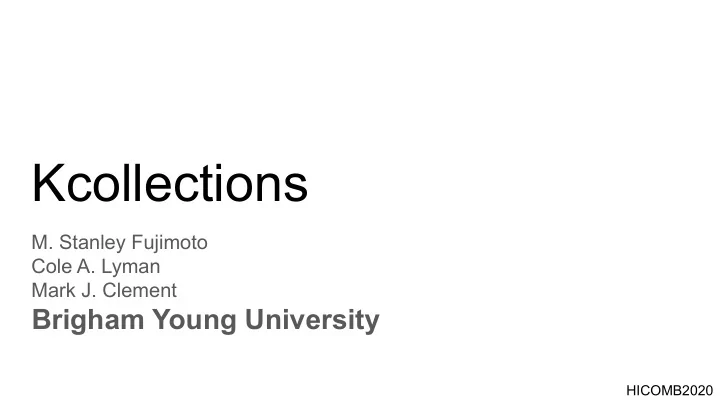

Kcollections M. Stanley Fujimoto Cole A. Lyman Mark J. Clement Brigham Young University HICOMB2020
Why ● Many bioinformatic algorithms are based on k-mers ● Prototyping new algorithms based on new algorithms can be difficult because: ○ The number of possible k-mers grows exponentially as k increases ○ Storing k-mers for even moderately sized k becomes impossible on desktop hardware We propose an efficient and fast method for storing k-mers, kcollections, for broad bioinformatic applications HICOMB2020
How ● Take advantage of common k-mer serialization techniques to: ○ Store k-mers in an efficient data structure (burst trie) ○ Parallelize insert and look-up operations HICOMB2020
How - Serialization K-mers are commonly bit-packed using only 2 bits per base for efficient storage. We exploit the compact, serialized k-mers for further storage and speed efficiency. HICOMB2020
How - Efficient Storage, Trie Shared prefixes amongst k-mers are redundant. Remove redundant information by storking k-mers in a trie. A C ATAA A ATAC T ATAT ATCA AT C ATCG A ATGG GG G HICOMB2020
How - Efficient Storage, Burst Trie Use a burst trie to manage/minimize the creation of new children vertices. Children vertices are stored in a condensed array. Children Vertex Array A C ATAA A ATAC T ATAT ATCA AT C ATCG A ATGG GG G
How - Parallelization, Map Multi-threaded insert is done by mapping incoming k-mers to appropriate threads which are responsible for a partition of the trie. Bit shifting quickly identifies the appropriate partition/thread a k-mer should be sent to.
How - Parallelization, Reduce Merging partitions is simple: use bitwise operation to merge housekeeping variables and concatenate children vertices from each partition.
How - Parallelization, Look-Ups Look-ups are thread-safe. HICOMB2020
How - Parallelization, Look-Ups Serialize k-mer query: AAGA -> 00100000 1. Presence Array Children Vertex Array
How - Parallelization, Look-Ups Serialize k-mer query: AAGA -> 00100000 1. Convert serialized k-mer to int: 00100000 -> 32 2. Presence Array Children Vertex Array
How - Parallelization, Look-Ups Serialize k-mer query: AAGA -> 00100000 1. Convert serialized k-mer to int: 00100000 -> 32 2. 3. Check presence array if pos 32 bit is set Presence Array Children Vertex Array
How - Parallelization, Look-Ups Serialize k-mer query: AAGA -> 00100000 1. Convert serialized k-mer to int: 00100000 -> 32 2. 3. Check presence array if pos 32 bit is set Presence Array 4. Bitshift array Children Vertex Array
How - Parallelization, Look-Ups Serialize k-mer query: AAGA -> 00100000 1. Convert serialized k-mer to int: 00100000 -> 32 2. 3. Check presence array if pos 32 bit is set Presence Array 4. Bitshift array 5. Popcount of array: 9 Children Vertex Array
How - Parallelization, Look-Ups Serialize k-mer query: AAGA -> 00100000 1. Convert serialized k-mer to int: 00100000 -> 32 2. 3. Check presence array if pos 32 bit is set Presence Array 4. Bitshift array 5. Popcount of array: 9 6. Retrieve item at index 9 in children vertex array Children Vertex Array
What - Performance Comparison HICOMB2020
What - Performance Comparison HICOMB2020
Acknowledgements ● Dr. Mark J. Clement ● Cole A. Lyman ● BYU Computational Sciences Laboratory HICOMB2020
Recommend
More recommend